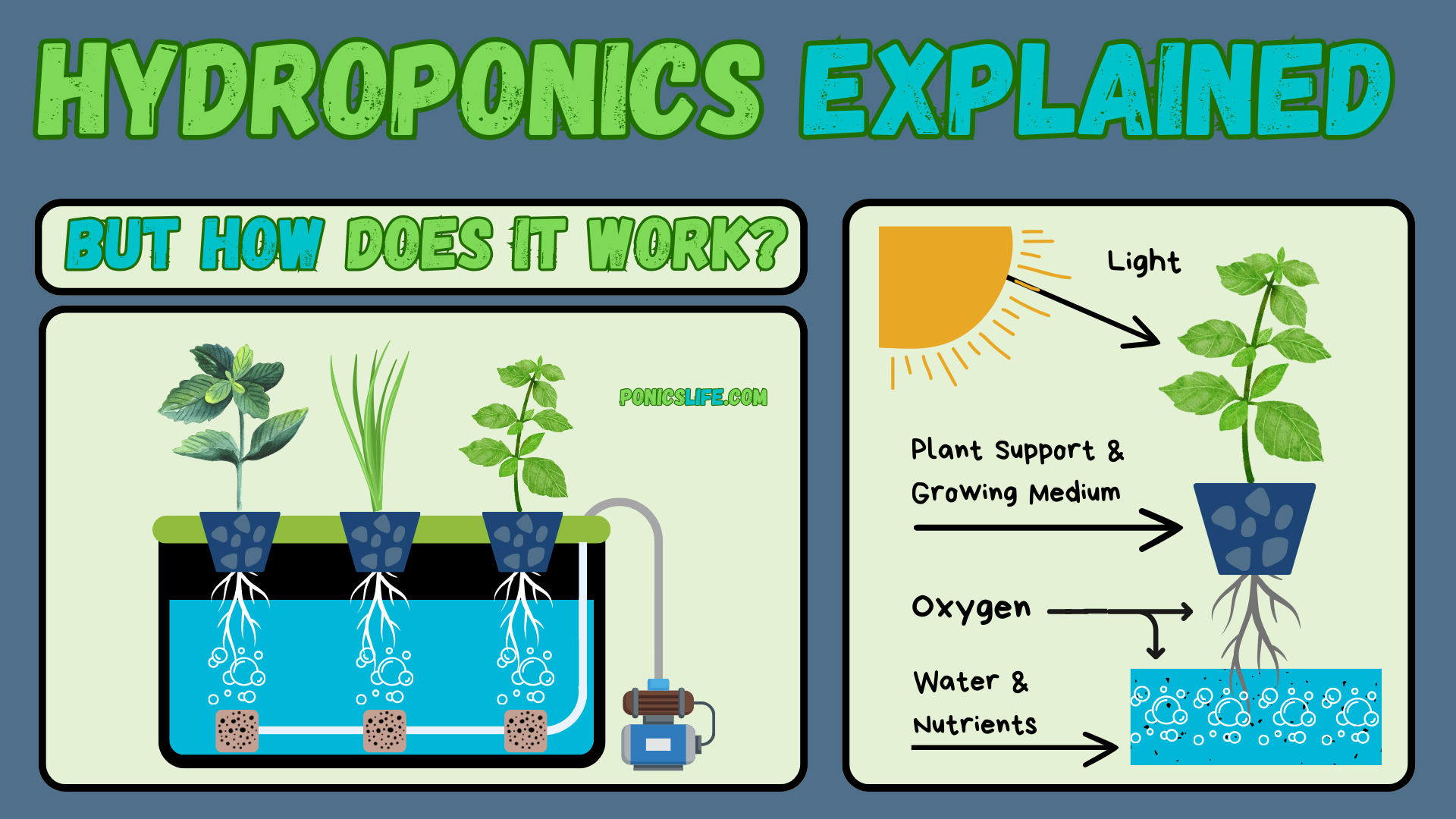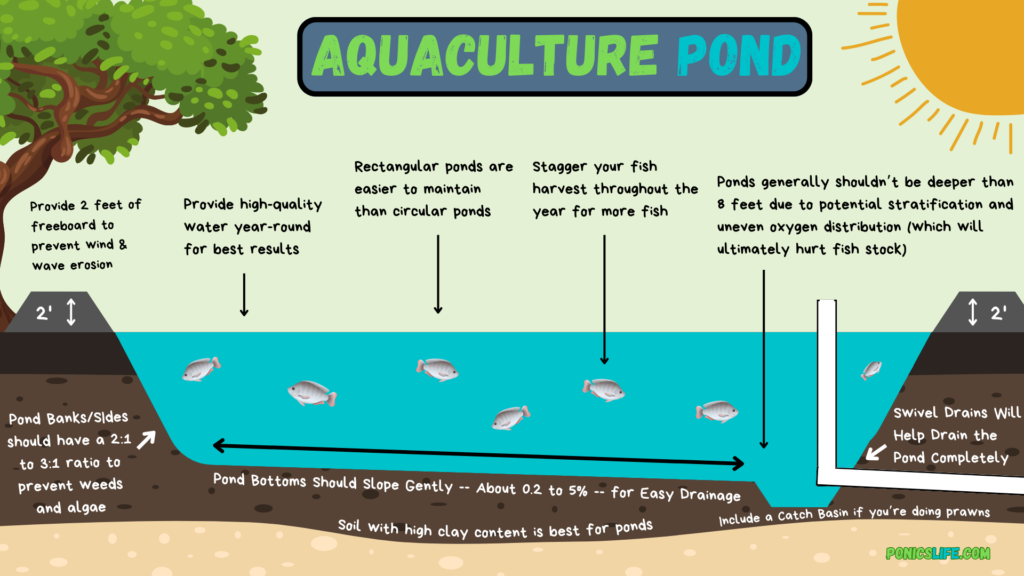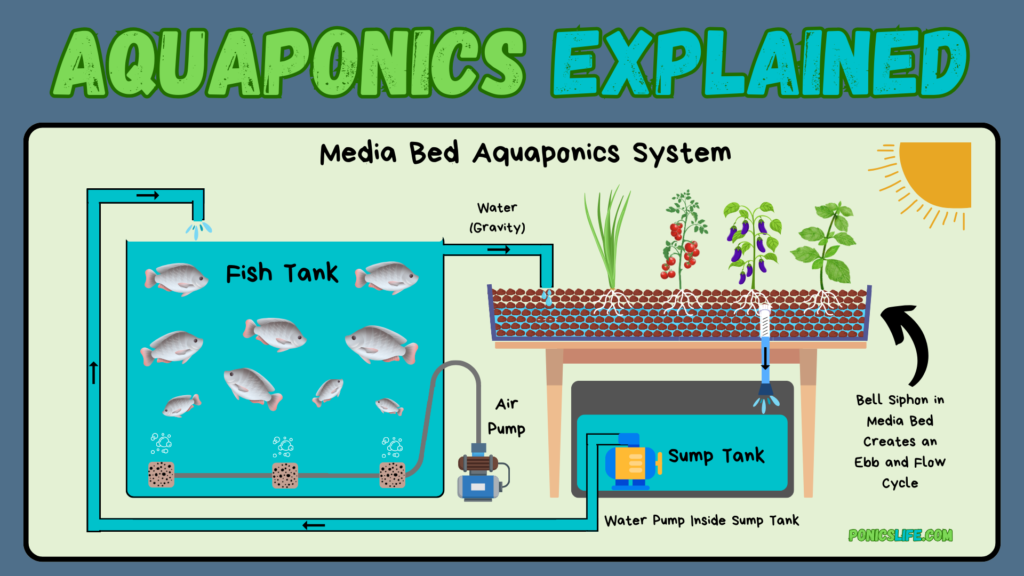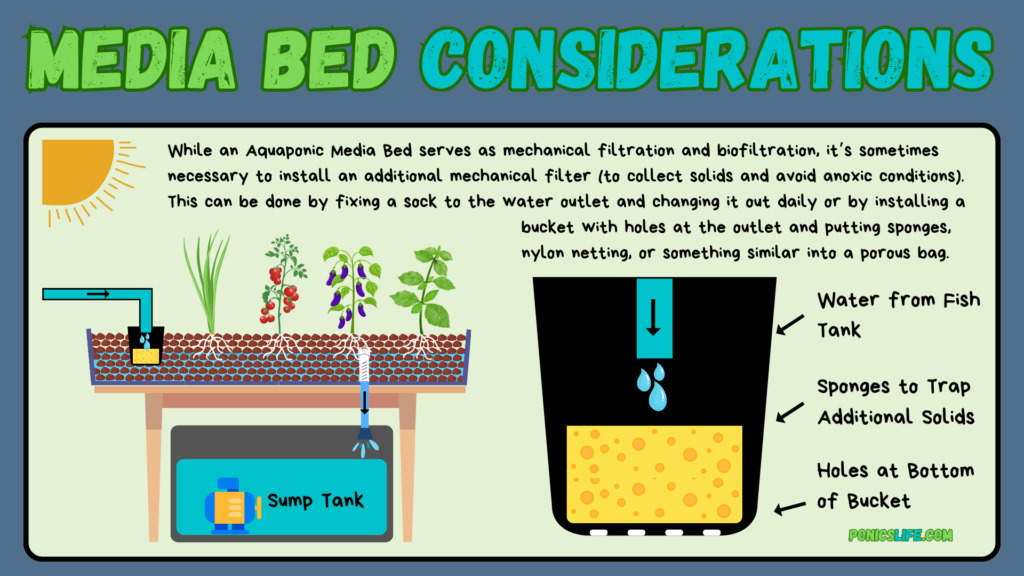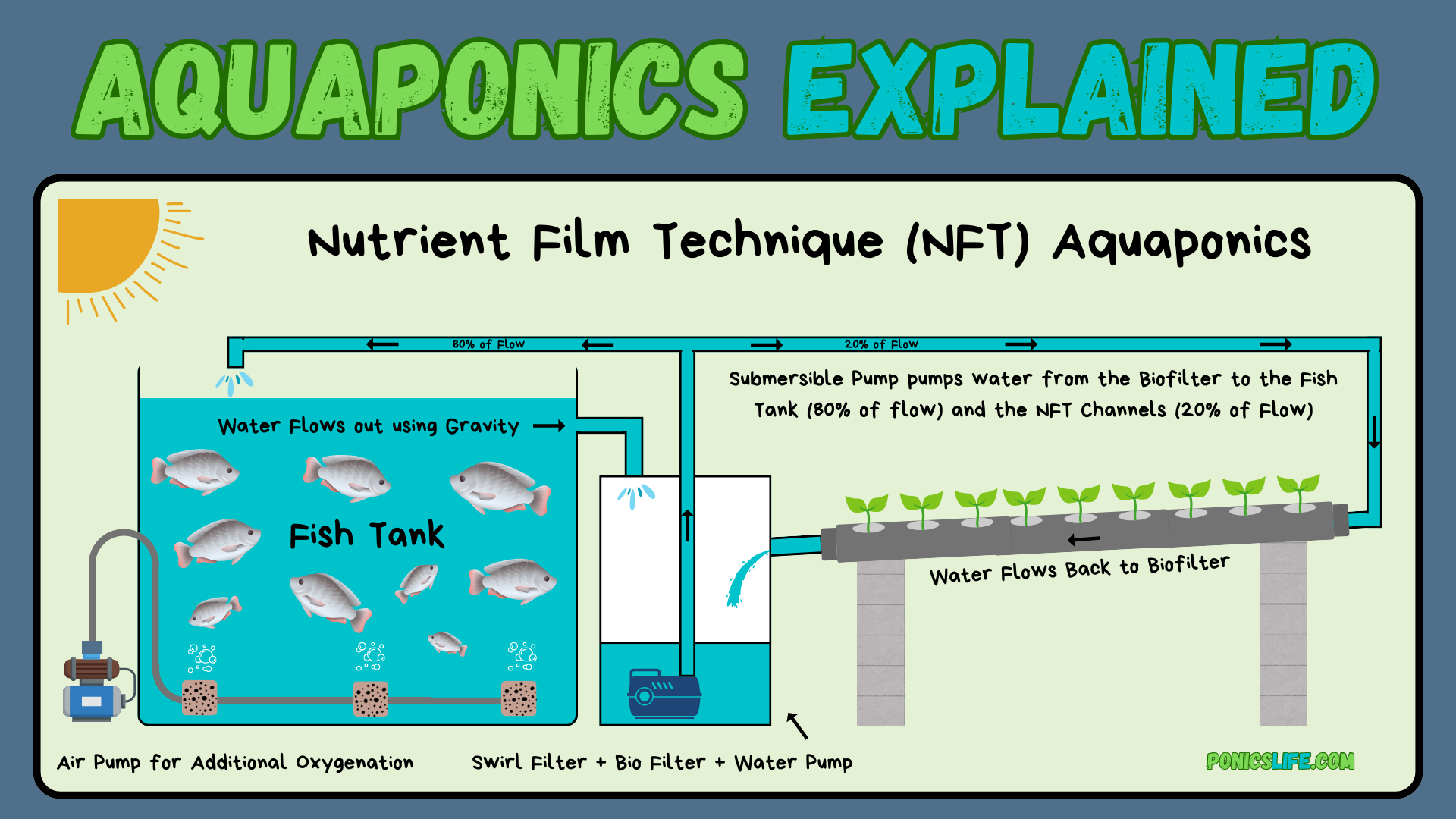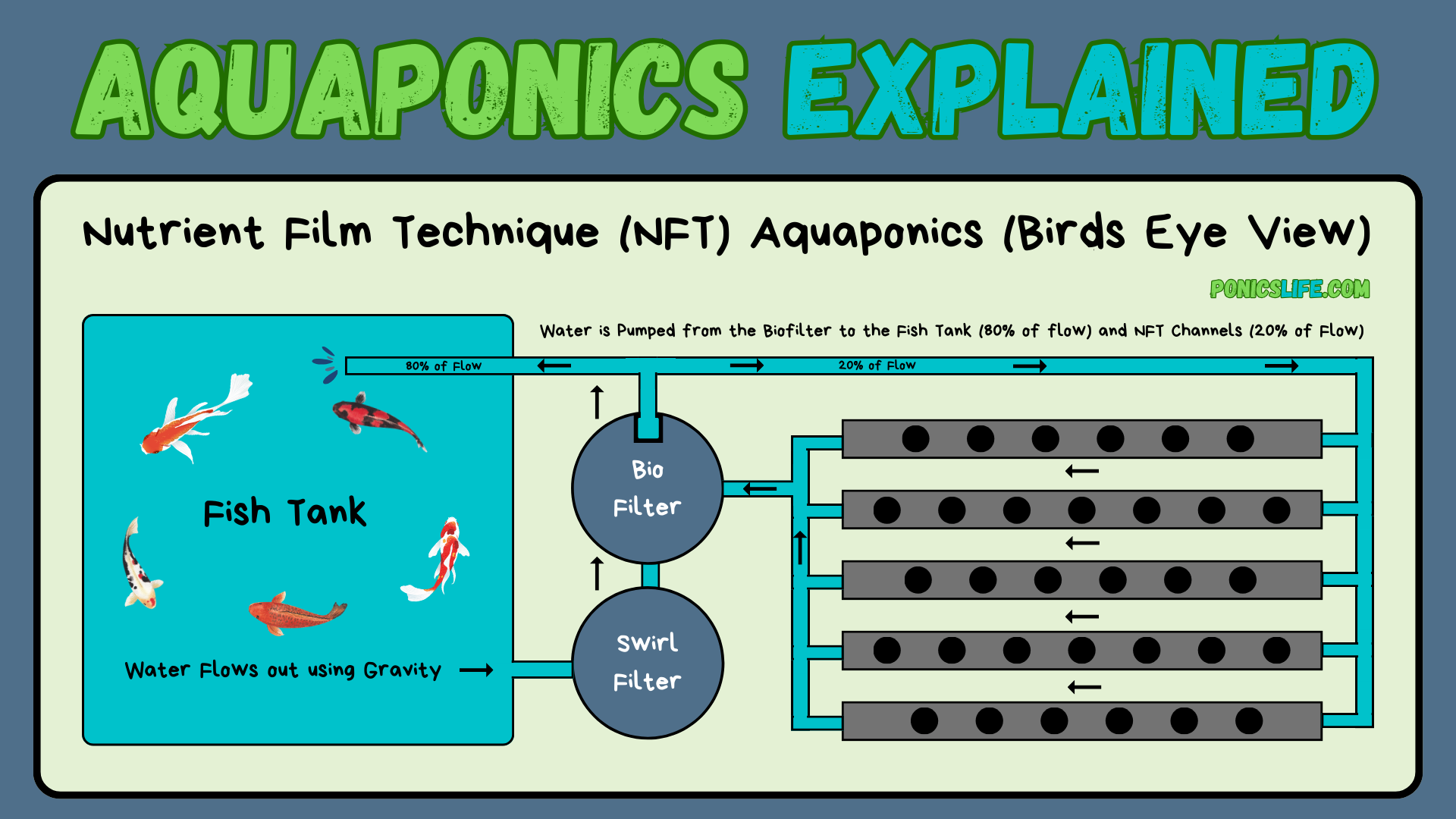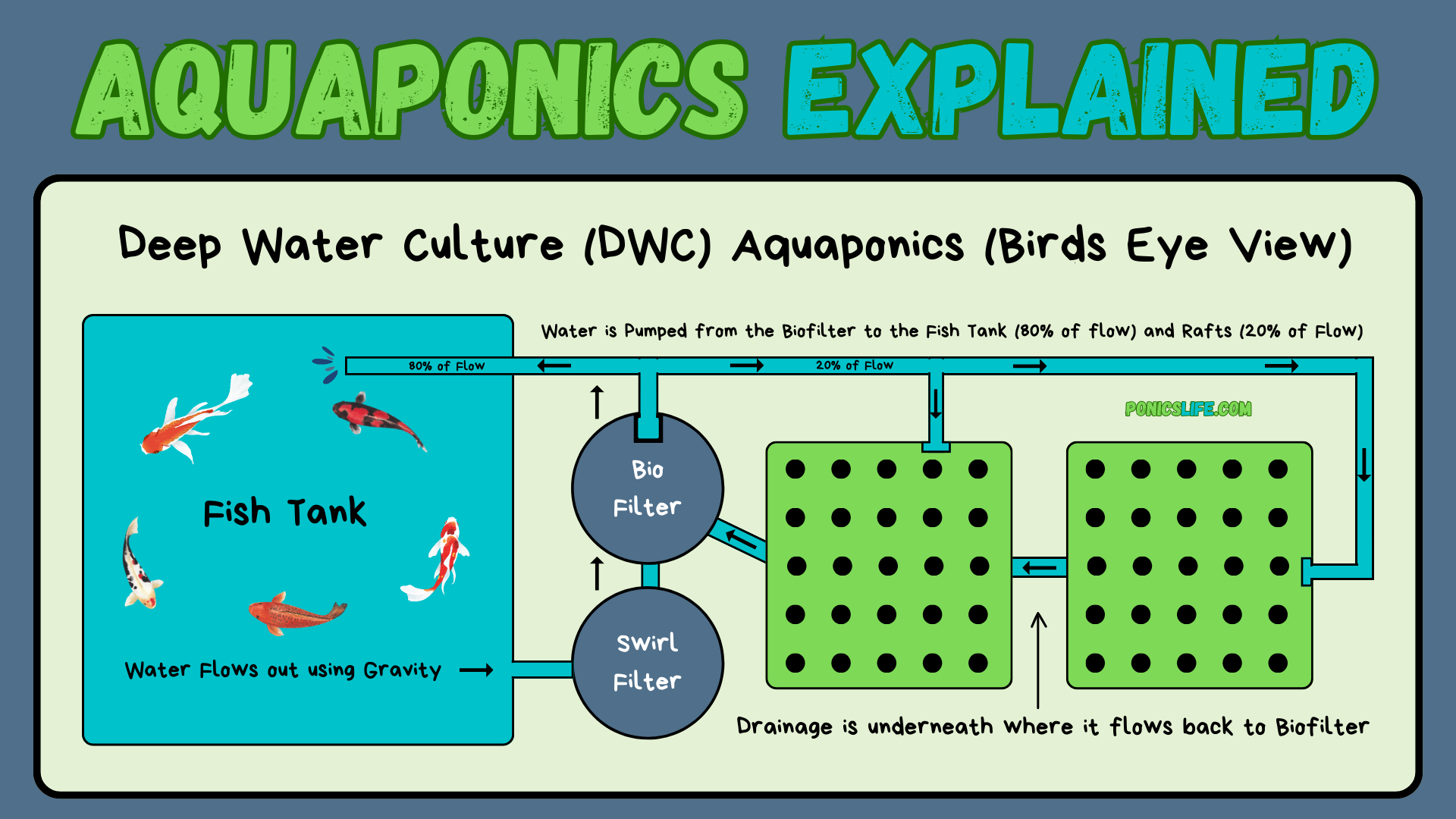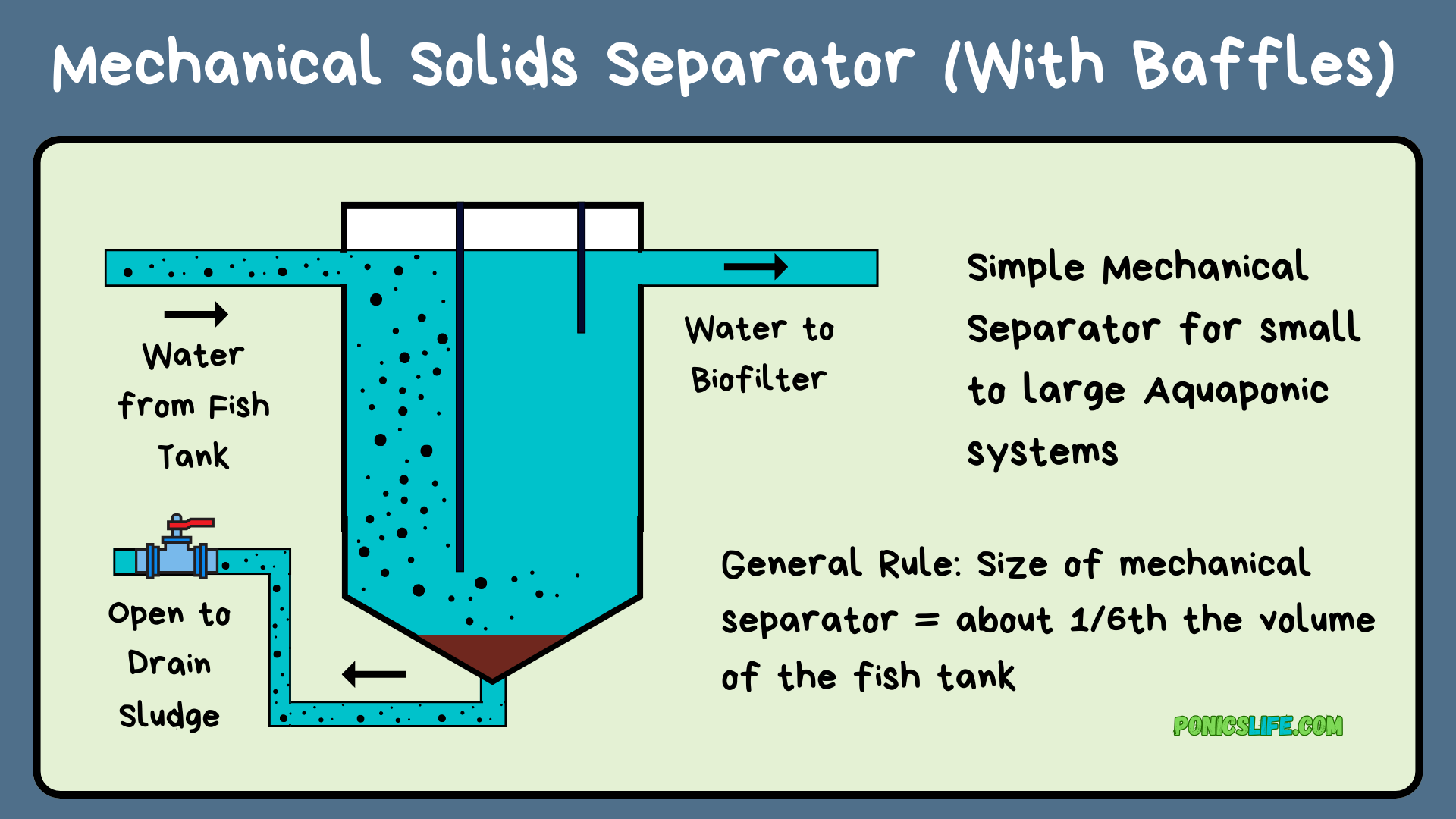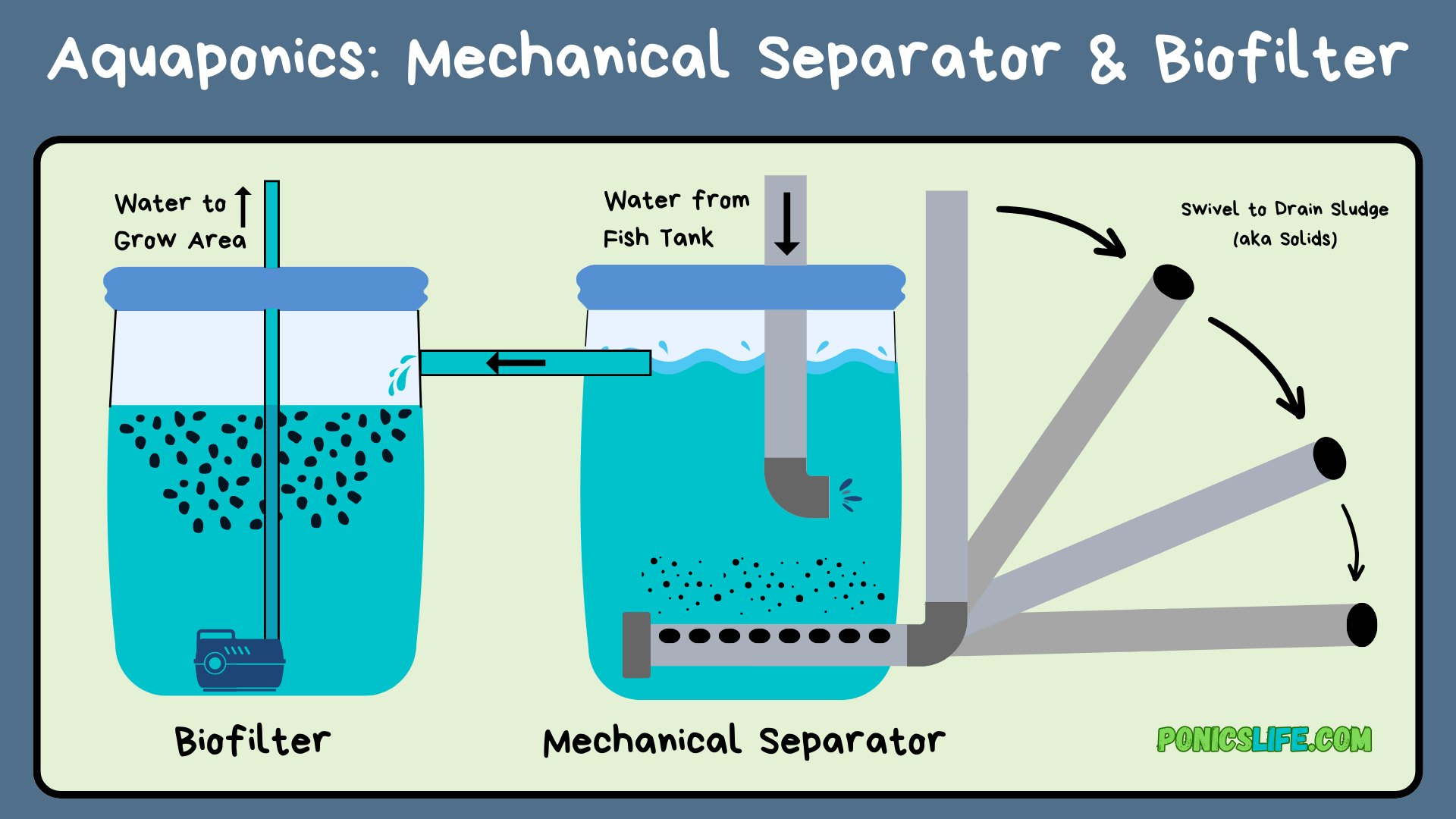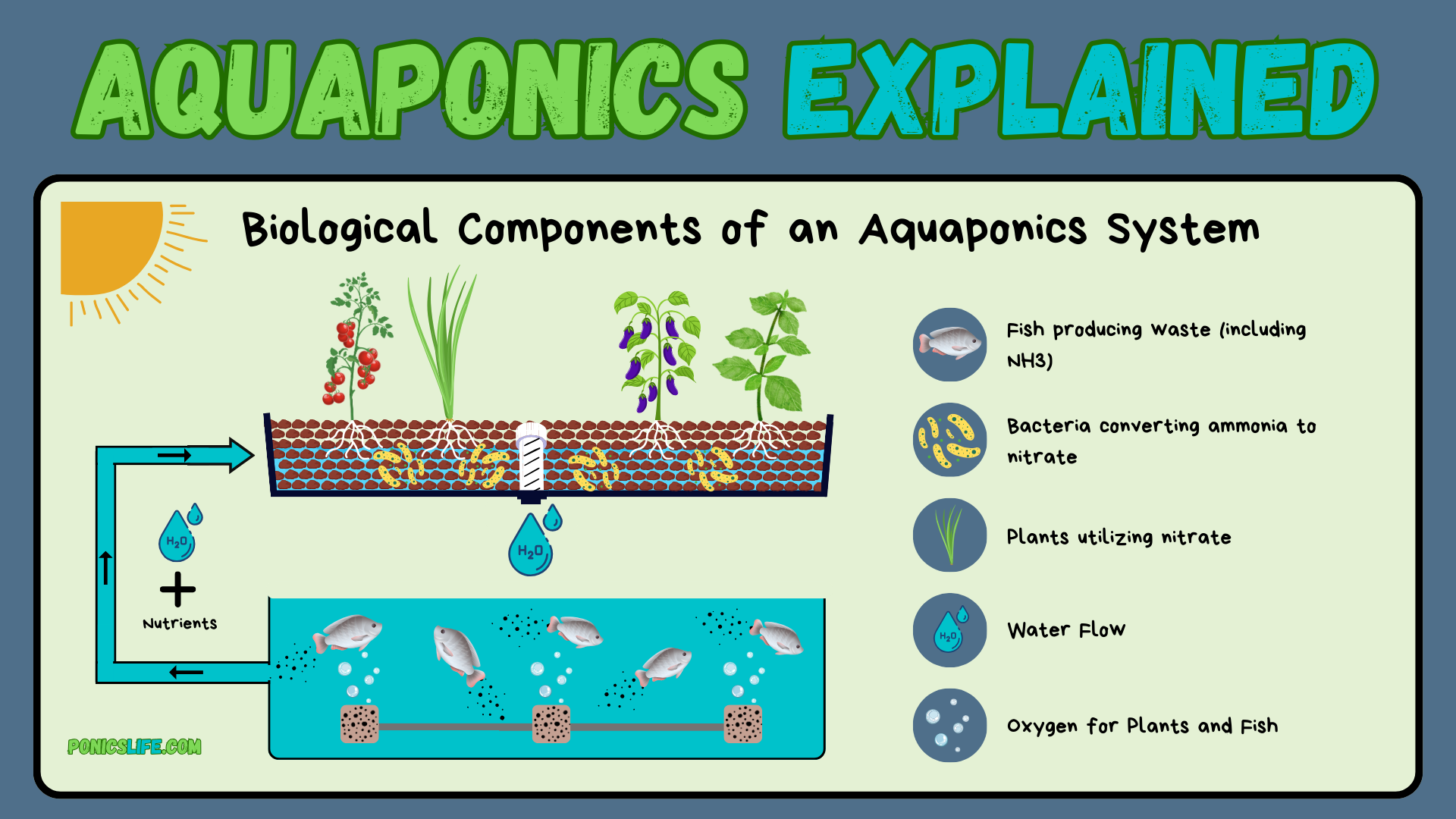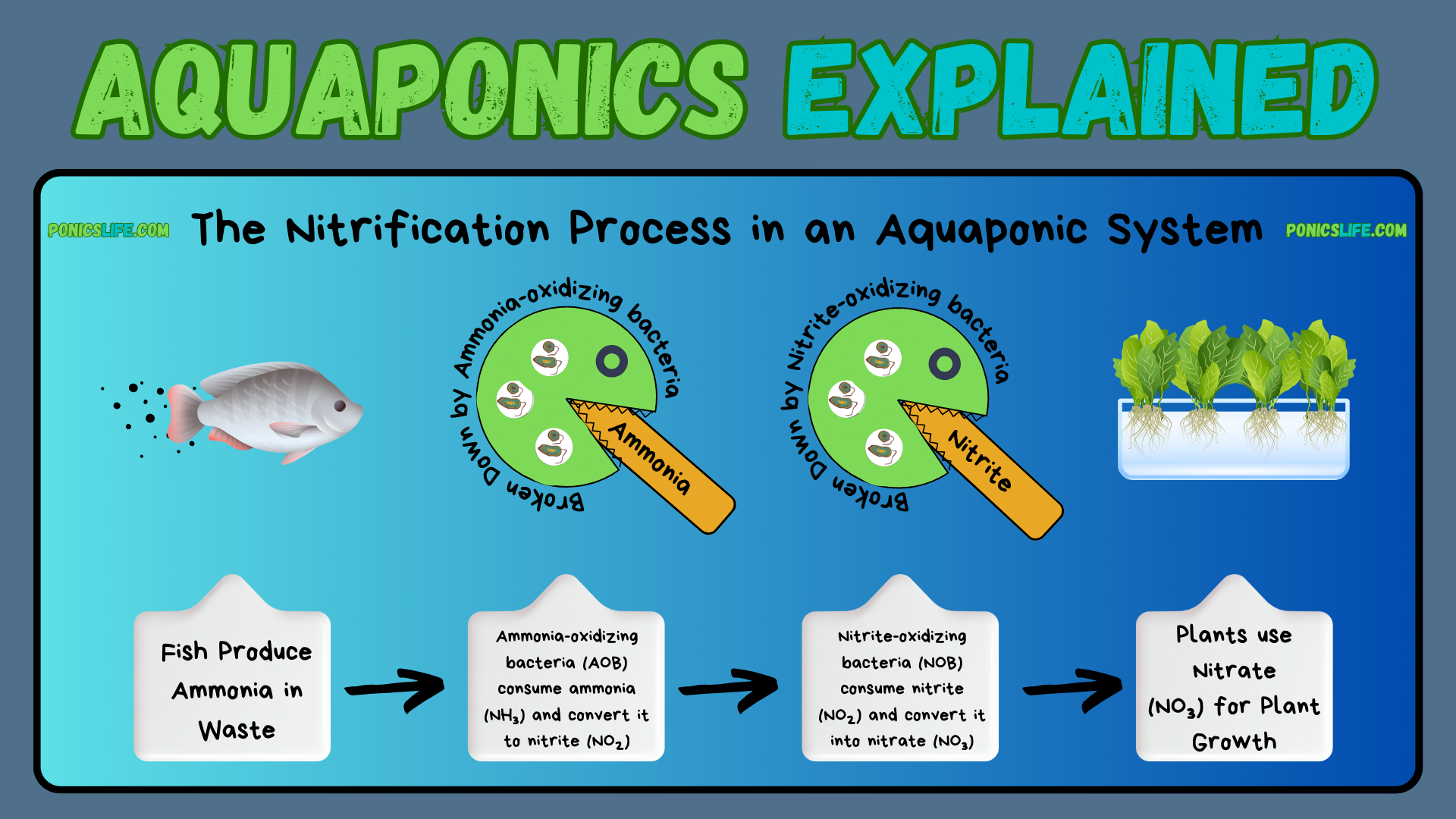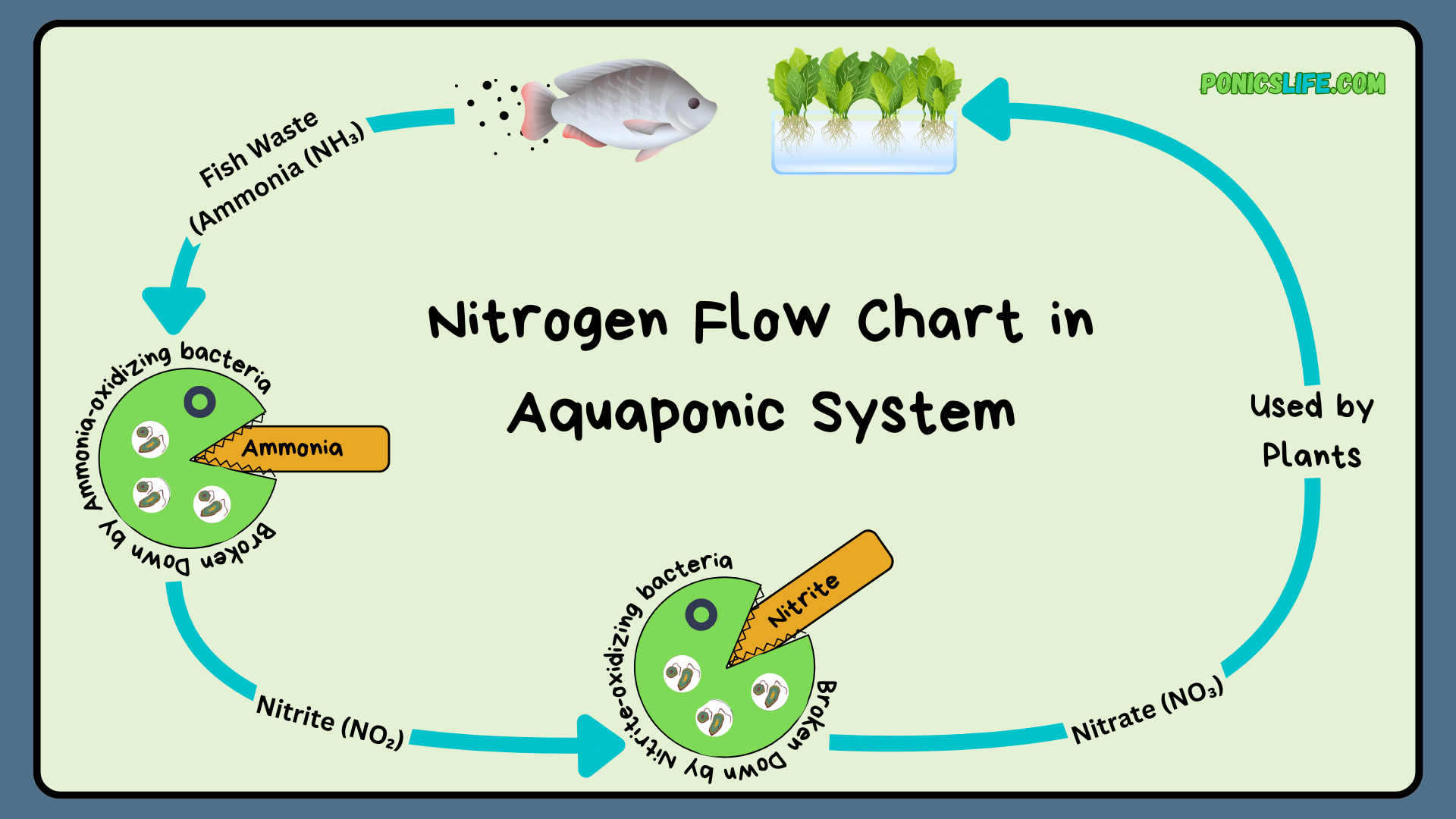Welcome to the Aquaponics Hobby Center
Explore the Ponics Life Aquaponics Hobby Center for the latest and greatest Aquaponic information!
What is Aquaponics?
Aquaponics is an innovative and sustainable method of agriculture that combines aquaculture (raising aquatic animals such as fish or prawns in tanks) with hydroponics (cultivating plants in water without soil) in a symbiotic environment. In this system, the waste produced by aquatic animals supplies nutrients for plants grown hydroponically, which in turn purify the water that goes back to the fish tank. This creates a closed-loop system that mimics a natural ecosystem, where the waste of one species provides food for another, resulting in a highly efficient and resource-conserving method of food production.
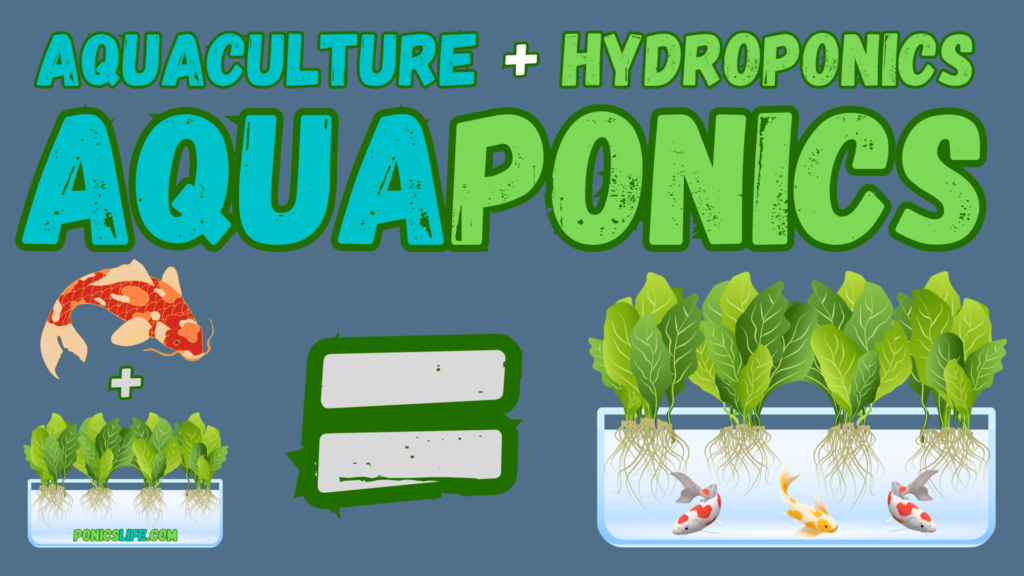
One of the key advantages of aquaponics is its water efficiency, making it particularly suitable for areas with limited water resources. It eliminates the need for chemical fertilizers, as the fish waste provides organic nutrients for the plant growth. Moreover, aquaponics can be set up in a variety of ways, from small indoor or backyard setups to large commercial operations, providing a versatile solution for sustainable agriculture. Its ability to produce both high-quality protein from fish and fresh vegetables simultaneously makes aquaponics an innovative approach to food production that has the potential to contribute to global food security.
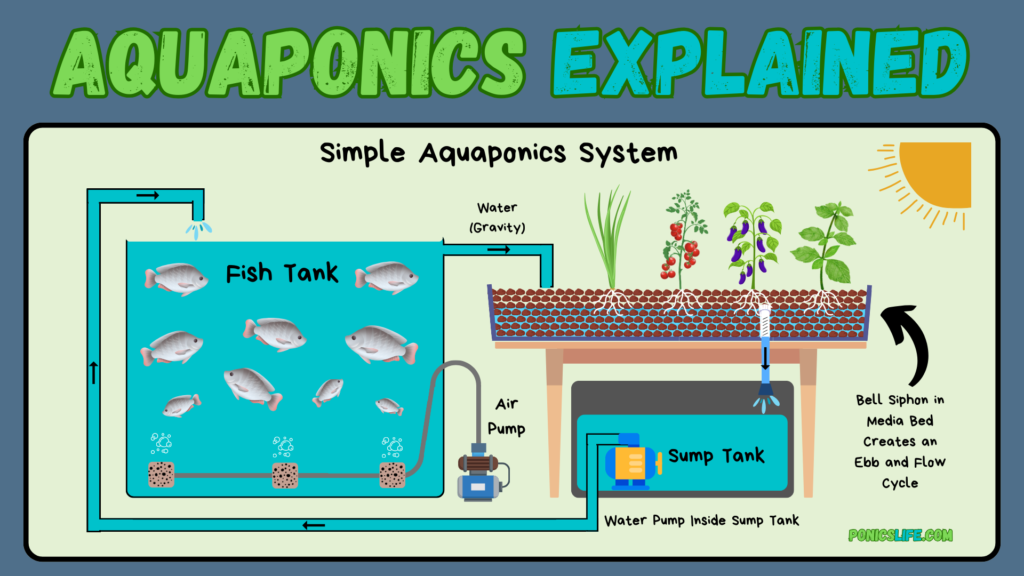
For hobbyists, aquaponics offers a fascinating and rewarding way to dive into sustainable gardening and fish farming from the comfort of one’s own home. This eco-friendly system not only allows enthusiasts to grow fresh vegetables and herbs year-round but also to raise fish, creating a miniature ecosystem that thrives on a symbiotic relationship between plants and aquatic animals. Hobbyist aquaponics systems can vary from simple, small-scale setups in a backyard or garage to more complex indoor arrangements, appealing to a wide range of interests and spaces. It’s an engaging pursuit that teaches valuable lessons about the interconnectivity of life, requiring minimal outside resources and providing the satisfaction of producing one’s own food in an environmentally responsible manner.
What is Hydroponics?
Hydroponics is a method of growing plants without soil, using mineral nutrient solutions in a water solvent. This innovative approach allows plants to grow in controlled environments, where nutrients are delivered directly to their roots via a water solution, eliminating the need for traditional soil cultivation. The key principle behind hydroponics is to provide plants with precisely what they need, when they need it, in the most efficient and environmentally friendly manner possible. By carefully controlling the conditions under which the plants grow, including light, temperature, water, and nutrient levels, hydroponics enables faster growth rates and higher yields compared to conventional farming methods.
What is Aquaculture?
Aquaculture, commonly known as fish farming, refers to the breeding, rearing, and harvesting of plants and animals in all types of water environments including ponds, rivers, lakes, and the ocean. This practice encompasses a wide range of aquatic organisms, such as fish, crustaceans, mollusks, and aquatic plants, for purposes including food production, restoration of endangered species, building aquarium collections, and enhancing wild stock populations. Aquaculture serves as a crucial food source and has become increasingly important as the demand for seafood rises alongside the world's growing population.
The methods and operations in aquaculture are diverse, ranging from land-based tanks to open-ocean operations. Techniques vary widely and are tailored to the specific requirements of the species being farmed. For instance, some species may be raised in controlled indoor environments that allow for precise management of water quality and temperature, while others are farmed in open pens in natural or artificial water bodies. Aquaculture not only helps to relieve the fishing pressure on wild populations but also contributes to food security by providing a consistent and sustainable source of nutritious food. With advancements in research and technology, aquaculture practices continue to evolve, focusing on sustainability, efficiency, and reducing environmental impacts.
To learn more about aquaculture, here's some information on common backyard/hobbyist designs.
Advantages and Disadvantages of Aquaponics
Advantages of Aquaponics:
- Sustainable and Eco-Friendly: Aquaponics mimics natural ecosystems, recycling water and nutrients between fish and plants, drastically reducing the need for water and chemical fertilizers.
- Water Efficiency: This system uses up to 90% less water than traditional agriculture by recirculating water in a closed loop.
- Organic Crop Production: The absence of soil minimizes the risk of soil-borne diseases and pests, reducing the need for chemical pesticides, and the fish waste provides an organic nutrient source for plant growth.
- Space and Location Flexibility: Aquaponics can be implemented in various scales and settings, including urban areas, rooftops, and regions with poor soil quality, making it a versatile option for food production.
- Dual Outputs: The system produces both fish and plants, offering a source of protein and vegetables from a single system, enhancing food security.
- Year-Round Production: Controlled environment agriculture allows for the year-round growth of crops, independent of seasonal constraints.
Disadvantages of Aquaponics:
- High Initial Setup Costs: The upfront cost of setting up an aquaponics system, including tanks, pumps, filters, and grow beds, can be high, potentially limiting accessibility.
- Technical Knowledge and Management: Successful aquaponics requires a good understanding of both aquaculture and hydroponics, as well as diligent monitoring and management to maintain the balance between fish and plant health.
- Energy Consumption: Systems often rely on electrically powered pumps and, in some cases, artificial lighting, which can lead to significant energy use.
- Limited Crop Selection: Not all plants are suited to aquaponic systems, with most success seen in leafy greens and herbs; root vegetables and some fruiting plants may pose challenges.
- Disease and Pest Management: While reduced, there is still a risk of disease and pests, and managing these without harming the fish or plants can require careful, often organic, solutions.
- System Balance and Stability: Achieving and maintaining the delicate balance between fish and plant needs can be challenging, especially for beginners, and disruptions in this balance can lead to system failure.
History of Aquaponics
The history of aquaponics can be traced back through various cultures and civilizations, evolving over centuries into the integrated system we recognize today. According to the FAO (Food and Agriculture Organization of the United Nations) Aquaponics Small Scale Aquaponic Food Production guide and other academic sources, the roots of aquaponics blend ancient aquaculture and hydroponics practices.
One of the earliest instances of aquaponics can be found in the rice fields of China and Thailand, where fish were raised alongside the cultivation of rice in a symbiotic relationship, enhancing productivity and sustainability. This method, known as paddy field fish culture, dates back thousands of years and represents an early form of integrating aquatic and plant life for mutual benefit.
Further back, the Aztecs developed a system known as chinampas or "floating gardens" around the 12th century in the valley of Mexico. These were essentially man-made islands on lake surfaces where they cultivated plants on the water's surface, with the roots extending into the water below. While not aquaponics in the strictest sense, this system represented an early understanding of growing plants in close association with water and fish, providing a precursor to modern aquaponics systems.
In more recent history, the integration of aquaculture and hydroponics into a closed-loop system began to take shape in the 20th century. Researchers and hobbyists experimented with ways to combine fish waste as a nutrient source for plants, which in turn purified the water for the fish. This concept was further developed and refined in the 1970s and 1980s, with significant contributions from the New Alchemy Institute and various academic institutions, leading to the modern aquaponics systems we see today.
The term "aquaponics" itself, a portmanteau of "aquaculture" (the raising of fish) and "hydroponics" (the soil-less cultivation of plants), reflects the seamless integration of these two components into a sustainable and efficient production system. Today, aquaponics is recognized not only for its historical significance but also for its potential to address contemporary challenges in food production, water conservation, and sustainable agriculture.
Throughout its history, aquaponics has demonstrated the enduring human interest in developing agricultural techniques that are harmonious with nature. As we face increasing environmental challenges, the principles underlying aquaponics offer valuable insights into sustainable practices that can support food security and ecological balance.
Aquaponics for Hobby Applications
Aquaponics for hobbyists has emerged as a popular and engaging way to explore sustainable food production within the comfort of one’s own space, whether it's a backyard, balcony, or even indoors. This innovative method of combining fish farming (aquaculture) with soilless plant cultivation (hydroponics) appeals to a wide range of enthusiasts, from gardening aficionados to those interested in sustainable living and DIY projects. Hobby applications of aquaponics vary in size and complexity, catering to different levels of interest and commitment, making it accessible to nearly anyone curious about this eco-friendly approach to growing food.
For hobbyists, aquaponics offers several compelling advantages. It allows for the production of fresh, organic produce alongside nutritious fish, creating a self-sustaining ecosystem that mimics natural processes. This not only results in a reduction of waste but also conserves water, making it an environmentally responsible choice. Moreover, aquaponics systems can be set up almost anywhere, offering a solution for growing food in areas with limited space or poor soil quality.
Getting started with aquaponics typically involves selecting a suitable system design that can range from simple, single-container setups to more complex arrangements with multiple tanks and grow beds. Common fish species used in hobbyist systems include tilapia, goldfish, and koi, while popular plant choices often consist of leafy greens, herbs, and other vegetables that thrive in a soilless aquatic environment.
Despite its many benefits, aquaponics for hobbyists does come with challenges. It requires a balance between the needs of the fish and the plants, which can take time and experimentation to achieve. Hobbyists must learn about both aquaculture and hydroponics, including water chemistry, fish health, and plant care. The initial setup and ongoing maintenance costs can also be considerations, as can the system's energy requirements for pumping water and, in some cases, lighting the plants.
Nevertheless, the growing community of aquaponics enthusiasts and the wealth of available resources, from online forums and social media groups to books and workshops, provide ample support for those looking to dive into this rewarding hobby. Through trial and error, research, and community engagement, hobbyists can cultivate not only fresh food but also a deeper connection to the environment and the principles of sustainable living.
Aquaponics for Schools and Education
Aquaponics presents a dynamic and innovative platform for schools and educational institutions, offering a hands-on learning experience that spans multiple disciplines, including biology, chemistry, environmental science, and agriculture. By integrating an aquaponics system into the curriculum, educators can illuminate the principles of ecosystems, sustainable farming practices, and the science behind plant and aquatic life, providing students with a real-world application of these concepts.
In an educational setting, aquaponics serves as a living classroom where students can observe the symbiotic relationship between fish and plants. Fish produce waste that, with the help of beneficial bacteria, is converted into nutrients for the plants. In turn, the plants filter and clean the water, which is then recirculated back to the fish. This closed-loop system not only demonstrates the nitrogen cycle and biological filtration but also teaches students about the importance of water conservation and the potential for sustainable food production systems.
Furthermore, aquaponics in schools encourages critical thinking, problem-solving, and engagement with STEM (Science, Technology, Engineering, and Mathematics) subjects in a practical and interactive manner. Students can monitor water quality, test pH levels, observe plant and fish health, and even design and innovate system components, fostering a deeper understanding of scientific principles and engineering processes.
Beyond the academic benefits, aquaponics programs can instill a sense of responsibility and stewardship in students as they learn about the impact of human activities on the environment and the importance of sustainable practices. It also offers opportunities for interdisciplinary learning, connecting science with nutrition, culinary arts, and economics, as students can potentially harvest and market their produce.
Implementing aquaponics in schools can also promote teamwork, as students collaborate on maintaining the system, and can enhance community engagement through projects that involve local businesses, universities, and environmental organizations. By providing a tangible and interactive learning experience, aquaponics fosters an enriching educational environment that prepares students for future challenges and opportunities in a rapidly changing world.
Latest Aquaponic Articles
Aquaponic Systems
Explore the 3 Basic Types of Aquaponic Systems
There are 3 basic types of aquaponic systems and thousands of variations. When designing and building your own system, we recommend that you start with something easy — such as the Media Bed — and gradually work your way up to more complex systems. And remember, aquaponics takes patience! Just like hydroponics, it truly is a trial and error kind of hobby and you’ll undoubtedly make some mistakes as you grow. What’s important is that you don’t give up! To learn more about the 3 types of aquaponic systems — Media Beds, Nutrient Film Technique (NFT), and Deep Water Culture (DWC) — open and read through the dropdowns below.
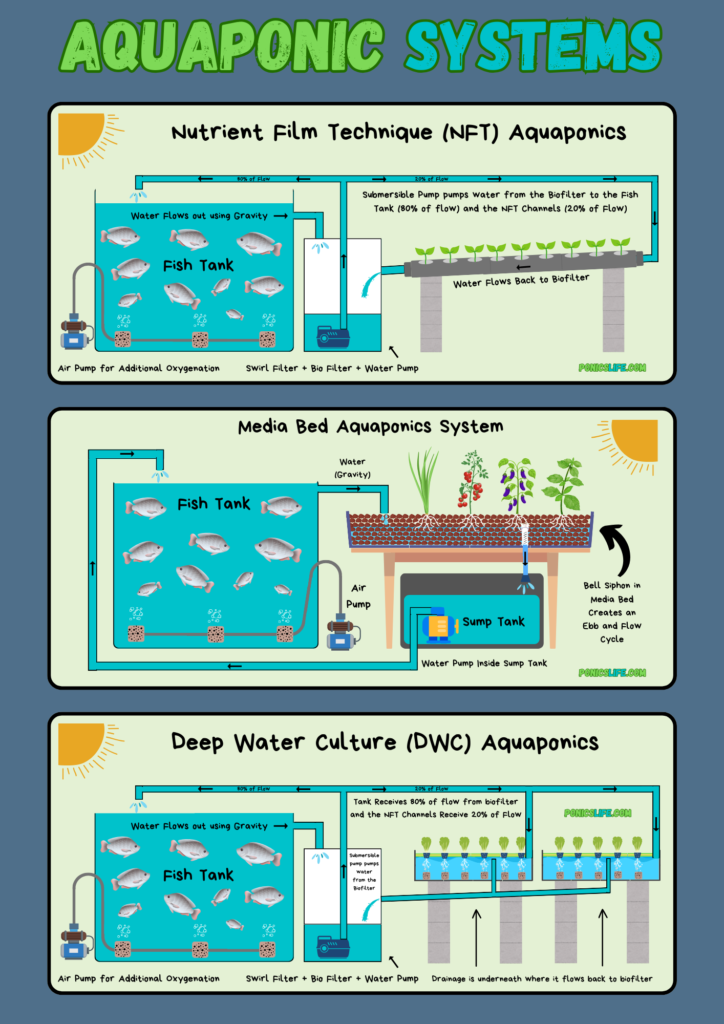
Deep Water Culture (DWC) Aquaponics
Deep Water Culture (DWC) in aquaponics represents a sophisticated yet straightforward method for growing plants, primarily characterized by its use of polystyrene sheets to suspend plants above water, with their roots delicately dangling into a nutrient-enriched aquatic environment. This technique is especially prevalent in large-scale commercial operations focused on cultivating specific crops like lettuce, salad leaves, or basil. Although the DWC method can offer a higher level of complexity compared to simpler media beds, making it potentially challenging for small-scale implementations or in regions with limited access to necessary materials, its benefits in commercial settings are significant.
In DWC systems, the core principle involves a continuous flow of water, similar to that in Nutrient Film Technique (NFT) setups. Water from the fish tank is guided through a mechanical filter into a biofilter/sump combination, from which it is distributed to plant rafts and then back to the biofilter and fish tank, completing a cyclical journey. This "Figure 8" path ensures that the water is adequately filtered and oxygenated, benefiting both the aquatic and plant components of the system. Notably, DWC systems manage to mitigate nutrient depletion issues seen in NFT systems due to the vast volume of water in the grow areas, which retains sufficient nutrients for plant uptake even in long raft setups.
The construction and planting within DWC raft areas require specific considerations to optimize plant growth and system efficiency. Raft/Grow Areas can vary in length, accommodating extensive nutrient supply due to their significant water volume, with width generally aligned with standard polystyrene sheet dimensions. Depth is recommended at 30cm (about 12 inches) to provide ample space for root development. Material choice for the grow area should prioritize strength and water-holding capacity, with popular options including modified IBC containers or custom-built enclosures using inert, non-toxic materials.
Mechanical and biological filtration is crucial in DWC as in NFT, necessitating dedicated systems to remove solid wastes and facilitate nitrification. This filtration ensures the water remains clean and rich in nutrients, suitable for recirculation to both fish and plants. Additionally, aeration within the raft/grow area is vital, with air stones or other aeration methods employed to maintain optimal dissolved oxygen levels, supporting both plant root health and microbial activity essential for nutrient cycling.
It's important to note that there are some low fish density designs/setups that don't require additional filters, relying solely on plant roots and surfaces within the grow area to host beneficial bacteria. This approach reduces complexity and initial costs but necessitates careful management of fish feeding and water quality to prevent system imbalance.
Despite potential drawbacks in scalability and intensive management requirements, the DWC technique, with its simplicity and efficiency in large-volume nutrient delivery, remains a cornerstone of both commercial and backyard aquaponic farming, offering a viable path to high-yield, sustainable plant production.
Essential Aquaponic Components
Basic Components of Aquaponic Systems: Fish Tank, Filtration: Mechanical and Biological, Water Movement, Aeration, Sump Tank, and Materials
Fish Tank
Fish tanks play a pivotal role in the success of any aquaponic system, representing a significant portion of the overall investment. Essential for housing and nurturing fish, these tanks must be carefully selected and designed to meet the specific needs of the aquatic inhabitants. Factors such as shape, material, and color significantly influence the functionality and efficiency of fish tanks in aquaponics.
Shape of Fish Tanks
- Round Tanks with Flat Bottoms: These are preferred due to their facilitation of uniform water circulation and natural waste collection at the center, aided by centripetal force.
- Square Tanks: Also viable but demand more effort in waste removal due to less efficient circulation.
- Non-Geometric Shapes: While unique, they risk creating dead zones with stagnant water, potentially harmful to fish. These may require additional circulation aids like pumps.
- Space for Species: The tank's design should accommodate the specific space and swimming needs of the chosen fish species.
Material Choices
- Plastic or Fiberglass: These materials are favored for their durability, ease of installation, and resistance to weathering. Metals are avoided due to corrosion risks.
- UV Resistance: For plastic tanks, UV-resistant options like low-density polyethylene (LDPE) are ideal to prevent degradation by sunlight.
- Alternative Constructions: In-ground ponds lined with cement or plastic offer a budget-friendly choice but come with their own set of management challenges.
Color Considerations
- Light Colors: White or pale-hued tanks are recommended for better visibility of fish and to monitor waste accumulation. They also reflect sunlight, helping to regulate water temperature.
- Insulation: In extreme climates, additional insulation may be required to maintain optimal water temperatures for fish health.
Covers and Shading
- Necessity of Covers: Covers are essential for preventing algae growth, deterring predators, and keeping fish safely within the tank.
- Shade Cloths: These are commonly used to block significant portions of sunlight, attached to a frame for easy handling.
Safety Measures and Redundancy
- Preventing Drainage: Critical design elements should prevent accidental tank drainage, ensuring water levels are maintained even in the event of equipment failure.
- Water Pump Placement: Pumps should be positioned to avoid complete tank drainage, and standpipes can be employed to set a minimum water level.
In conclusion, the careful selection and design of fish tanks are fundamental to the health of the aquatic life within an aquaponic system. By considering the appropriate shape, material, and color, alongside implementing protective measures like covers and shade cloths, aquaponic growers can ensure a stable and productive environment for their fish. This careful planning not only contributes to the wellbeing of the fish but also to the overall success and sustainability of the entire aquaponic setup.
Mechanical Filter and Biofilter
In aquaponic systems, ensuring the health and efficiency of the ecosystem requires effective filtration methods to manage fish waste and maintain water quality. Filtration in aquaponics is twofold: mechanical and biological, both critical for sustaining a balanced environment for fish, plants, and beneficial bacteria.
Mechanical Filtration is pivotal for removing solid wastes from the water, preventing the accumulation of harmful gases released by anaerobic decomposition and ensuring unobstructed water flow for optimal plant root oxygenation. Mechanical filters range from simple screens between the fish tank and grow bed to more complex systems like swirl filters and radial-flow separators designed to efficiently remove up to 60% or more of solid wastes. The choice of mechanical filtration largely depends on the system's scale and fish density, with smaller setups benefiting from straightforward screen and bucket filters and larger systems requiring sophisticated separators to manage higher waste volumes. Regular maintenance, including rinsing and removing collected wastes, is essential to prevent clogging and ensure effective filtration.
Pictured here are two types of mechanical filters/separators for solids (aka fish waste). The top one incorporates a "swirl" function, where water comes in at an angle and 'swirls' around the filter. As it swirls, it brings solids down to the bottom which can be drained using a rotating (or swiveling) piece of pvc. The bottom picture shows a mechanical filter/separator with baffles, where the water comes in and is immediately directed in a downward motion (because of the baffles). This ensures that solids flow to the bottom and clean (or cleaner) water moves to the top.
Important Note: these are by no means the only two types of mechanical filters for aquaponics! There are plenty of ways to design and build them so use what you think works best.
Biological Filtration plays a crucial role in converting harmful ammonia and nitrite from fish waste into beneficial nitrates, which plants can absorb as nutrients. This process is facilitated by specific nitrifying bacteria, necessitating a biofilter—a component designed to house these microorganisms and provide them with a large surface area and oxygen-rich water. Media such as Bioballs®, volcanic gravel, or even plastic bottle caps can serve as effective biofilter materials, with the key criteria being a high surface area to volume ratio, inertness, and ease of cleaning. For smaller aquaponic setups, media beds can double as biofilters, eliminating the need for separate biofiltration units. However, in systems without media beds, like those using nutrient film technique (NFT) or deep water culture (DWC), dedicated biofilters are indispensable.
In summary, effective filtration—both mechanical and biological—is fundamental to the success of an aquaponic system. Mechanical filters ensure the removal of solid wastes, preventing the buildup of harmful substances and ensuring clear water for plant and fish health. Biofilters convert dissolved wastes into nutrients for plants, facilitated by beneficial bacteria. Together, these filtration methods maintain the delicate balance of an aquaponic ecosystem, supporting the health and productivity of both aquatic and plant life.
Pictured above is the mechanical filter/separator and biofilter hooked up and working together. The Fish Tank water comes into the mechanical separator -- where solids are removed -- and then moves to the biofilter -- where the water is filtered -- and then moves to the grow area. The picture below shows a biofilter with a secondary/additional mechanical filter built in to the biofilter. This is typically utilized when your system has too many fish (aka your primary mechanical filter is receiving a lot of waste).
Important Note on Mineralization: the Mineralization of solid wastes, a process separate from but related to biofiltration, refers to the bacterial breakdown of solid fish wastes into dissolved nutrients available for plant uptake. While some systems deliberately retain solids within filters or media beds for mineralization, ensuring adequate water flow and oxygenation to prevent anaerobic conditions is crucial in most hobby setups. Alternatively, solid wastes can be collected and processed in a separate container or used as a valuable fertilizer outside the aquaponic system.
Water Movement
Water movement is the lifeline of aquaponic systems, ensuring the survival and thriving of fish, plants, and bacteria by facilitating the transfer of nutrients and oxygen. The process begins in the fish tanks, moving through mechanical and biological filters, and culminating in the plant grow area, where the nutrient-rich water nourishes the plants before being recirculated. A stop in water movement can lead to oxygen depletion and waste accumulation, creating lethal conditions for the system's inhabitants within hours.
For densely stocked systems, the recommended water circulation rate is twice per hour, meaning the entire water volume should pass through the system twice within this period to maintain optimal conditions. However, less densely stocked systems may only require a circulation rate of once per hour.
The primary methods of water movement in aquaponics include:
Submersible Impeller Water Pumps: These are the most common and recommended pumps due to their efficiency and simplicity in installation (think of a basic pond pump or aquarium pump). They're placed directly in the fish tank to pump water through the system, requiring minimal plumbing. High-quality, energy-efficient pumps are preferred for their durability and lower operational costs. When selecting and installing pumps, consider the flow rate, head height, and the diameter of plumbing pipes to minimize flow loss and maintenance frequency. Submersible pumps also necessitate periodic cleaning and should never be run dry, as this can cause damage.
Airlifts: An alternative to water pumps, airlifts use air to move water. Air is pumped to the bottom of a lift tube, creating bubbles that rise and pull water upwards. This method can be more energy-efficient, particularly in systems with small head heights or deep tanks where airlifts are more effective. Airlifts offer the added benefits of not clogging and simultaneously aerating the water, making them a cost-effective solution for both water movement and oxygenation. However, they require a sufficient volume of air to be effective and are typically more suitable for specific system designs.
Human Power: In situations where electricity is scarce or unreliable, human-powered methods can be employed to move water. This can range from manually filling header tanks to using pedal-powered pumps. While these methods are labor-intensive and less efficient, they are viable options for small systems or in regions with limited access to electricity. Such systems may face challenges with maintaining adequate dissolved oxygen levels and nutrient mixing but can be adapted to work effectively with careful management.
In summary, effective water movement is crucial for maintaining a healthy and productive aquaponic system. Whether through mechanical pumps, airlifts, or human power, ensuring consistent water flow prevents stagnation, supports aerobic conditions, and distributes nutrients evenly throughout the system. The choice of method depends on the system's size, density, and available resources, with a focus on optimizing oxygen levels and nutrient delivery to all parts of the aquaponic ecosystem.
Aeration
Aeration in aquaponics plays a critical role in ensuring the health and efficiency of the system by enhancing dissolved oxygen (DO) levels, crucial for fish, plants, and bacteria. Through the use of air pumps (such as a basic aquarium air pump or an air pump for a pond), air is injected into the water via air lines ending in air stones placed within the water tanks. These air stones break the air into fine bubbles, significantly increasing the water's oxygenation due to the larger surface area of smaller bubbles. The efficiency of oxygen transfer is maximized with high-quality air stones, which produce finer bubbles. Regular maintenance is required to prevent biofouling and ensure consistent air flow, including cleaning with chlorine solution and mild acid to remove deposits and mineralization.
In terms of system design, small-scale aquaponic systems typically incorporate at few air stones in the fish tank (and you can also put one in the biofilter). For hobbyists, it may be best to watch your system and visually inspect if your tank is receiving enough oxygen. If fish are gasping at the surface, it's typically an oxygenation issue.
Placement of air stones should be strategic to avoid the resuspension of settling solids, which could hinder their removal through the system's drainage.
Venturi siphons offer a low-tech alternative for increasing DO levels, especially beneficial in Deep Water Culture (DWC) grow areas. These devices operate on a hydrodynamic principle, where pressurized water flowing through a narrowed pipe section pulls in air due to the increased velocity and resulting negative pressure. This method introduces additional oxygen into the water without the need for electrical pumps, making Venturi siphons an effective redundancy measure for aeration, particularly in DWC setups.
Effective aeration strategies, including the use of air pumps and Venturi siphons, are crucial for maintaining optimal DO levels in aquaponics. These methods ensure the health and productivity of the aquaponic ecosystem by supporting the aerobic conditions needed for the well-being of fish, the efficiency of bacteria in nutrient cycling, and the overall growth of plants.
Sump Tank
The sump tank is an integral component of larger aquaponic systems, acting as a water reservoir situated at the system's lowest point, where water from various components is collected due to gravity. It typically houses a submersible pump that recirculates water back through the system (usually back to the fish tank).
Sump tanks are generally designed to be smaller than the fish tanks, with the capacity to hold between one-fourth and one-third of the fish tank's volume. This capacity is crucial for systems employing ebb-and-flow media beds, as the sump tank must accommodate the total volume of water drained from the grow beds during the flood cycle to prevent overflow and maintain a stable water level within the system.
While not mandatory for all aquaponic setups, sump tanks are particularly beneficial for systems exceeding 200 liters (53 gallons), as they offer a safeguard against water level fluctuations in the fish tank. These fluctuations could be caused by evaporation, leaks, or the normal operation of ebb-and-flow hydroponic units. For smaller units, a direct pump from the fish tank to the grow beds might suffice, with the water simply trickling back into the fish tank. However, this approach can risk the health and stability of the fish environment in the event of leaks or significant evaporation.
The CHIFT-PIST (Constant Height in Fish Tank - Pump In Sump Tank) method is widely advocated in aquaponics for its ability to maintain constant water levels in the fish tank, thereby ensuring the well-being of the aquatic inhabitants. By centralizing water loss and replenishment to the sump tank, this design simplifies the management of water levels, making it easier to track evaporation rates and identify leaks in the system. This method also protects the fish from potential harm due to water level drops caused by leaks in the hydroponic component of the system.
In summary, incorporating a sump tank into an aquaponic system enhances operational stability, simplifies water level management, and safeguards the aquatic environment, making it a valuable component for medium to large-scale aquaponic operations.
Materials
When assembling an aquaponics system, it's crucial to utilize specific plumbing materials to ensure a seamless and efficient flow of water throughout the entire setup. These materials are not just foundational to the construction of the system but also critical to its ongoing success and safety. Below, we outline the essential plumbing components and tools needed for building an effective aquaponics system.
Primary Plumbing Components:
- PVC Pipes and Fittings: At the heart of an aquaponics system's plumbing are PVC pipes along with a variety of PVC connections and fittings. These elements are indispensable for creating the network of channels that allow water to circulate between the fish tanks, filters, and grow beds.
- Hoses and Tubes: Flexible hoses and tubes complement the rigid PVC piping to accommodate various configurations and spaces within the system, offering versatility in setup.
- Bulkhead Valves and Uniseals®: For ensuring watertight connections through tank walls, bulkhead fittings/valves and Uniseals® are essential. These fittings allow pipes to pass through surfaces without leaking.
- Sealants: Silicone sealant and Teflon tape are necessary for sealing joints and preventing leaks. While PVC cement is used for permanent connections, silicone sealant can be a temporary solution when joints are not subjected to high water pressure.
Installation and Maintenance Tools:
- A range of general tools such as hammers, drills (both hand and electric saws), measuring tapes, pliers (including channel-locking pliers), screwdrivers, and levels are required for the assembly and maintenance of the system.
- A hole-saw or spade bit is particularly crucial for creating precise holes in fish tanks, filters, and grow beds, facilitating the insertion of plumbing components.
Materials Safety and Considerations:
- It's imperative to ensure that all plumbing materials have never been in contact with toxic substances to avoid contamination.
- Food-grade quality materials are recommended to prevent the leeching of harmful chemicals into the water, which could affect both plant and fish health.
- Utilizing black or non-transparent pipes is advised to inhibit algae growth, as light penetration through transparent materials can encourage algae formation within the plumbing.
Additional Recommendations:
- For detailed planning, make a comprehensive list of materials tailored for each specific unit or setup within your aquaponics system. This list should consider the unique requirements of different system types, such as NFT (Nutrient Film Technique) or DWC (Deep Water Culture) grow beds.
Selecting the right materials and tools is just the beginning of constructing an efficient and safe aquaponics system. By adhering to these guidelines, you can ensure a robust setup that supports sustainable growth and minimizes potential issues related to water flow, leaks, and contamination.
Biological Components and Water Quality
Aquaponic Nitrogen Cycle
The nitrogen cycle is extremely important to understand in aquaponics, underpinning the biological efficiency and sustainability of these integrated systems. This cycle is a complex but beautifully orchestrated series of processes that transform nitrogen (N), a vital element for all life forms, from one state to another, making it accessible to plants, animals, and bacteria. Nitrogen is crucial for the synthesis of amino acids, the building blocks of proteins necessary for the growth and functioning of all living organisms. While nitrogen is the most abundant element in the Earth's atmosphere, its gaseous form (N2) is inert and unavailable to most life forms without conversion into more reactive forms through the process of nitrogen fixation.
In aquaponic systems, the nitrogen cycle begins with fish excreting waste, primarily in the form of ammonia (NH3), into the water. This ammonia, along with other organic matter such as decaying plant material, becomes the substrate for nitrifying bacteria. These bacteria, naturally occurring in diverse environments, perform a crucial role by converting ammonia first into nitrite (NO2-) and then into nitrate (NO3-), a form of nitrogen that plants can readily absorb and utilize for growth. This conversion process not only provides essential nutrients for plant growth but also detoxifies the water for fish by removing harmful ammonia and nitrite.
The nitrification process involves two main types of bacteria: Nitrosomonas, which oxidize ammonia to nitrite, and Nitrobacter, which further convert nitrite to nitrate. These bacteria establish themselves on surfaces within the aquaponic system, such as the media in biofilters, where they form biofilms. These biofilms act as a living filter, breaking down fish wastes into plant-available nutrients while simultaneously purifying the water.
This cyclical interaction between fish, bacteria, and plants creates a symbiotic environment where each component benefits from the others. Fish provide the organic waste that bacteria convert into nutrients, and plants uptake these nutrients, effectively cleaning the water for the fish. This natural recycling of nutrients mimics the global nitrogen cycle but on a manageable, controlled scale within an aquaponic system.
Understanding and managing the nitrogen cycle is fundamental to the successful operation of an aquaponic system. It requires maintaining a balance between the fish load (and consequently, the amount of waste produced), the capacity of the biofilter and its bacterial population to process this waste, and the nutrient requirements of the plants being grown. Managing this balance ensures the health and productivity of both the aquatic and plant components of the system, making the aquaponic nitrogen cycle a key element in sustainable food production systems.
Maintaining a Healthy Bacterial Colony (Surface Area, Water pH, Water Temperature, Dissolved Oxygen, Ultraviolet Light)
Maintaining a healthy bacterial colony is crucial in aquaponics, as the bacteria are responsible for converting fish wastes into forms that plants can use as nutrients. This process, primarily involving nitrification, is essential for the health and productivity of both fish and plants. The efficiency of nitrification depends on several factors, including surface area, water pH, water temperature, dissolved oxygen levels, and exposure to ultraviolet (UV) light.
Surface Area
Bacteria thrive on surfaces such as plant roots, fish tank walls, and inside grow pipes. The amount of surface area available directly influences the capacity of bacteria to process ammonia. In systems with high fish stocking densities, a dedicated biofiltration component is necessary. This component often contains materials like gravel, tuff, or expanded clay, which have a high surface area and provide ample space for bacterial colonization.
Water pH
The pH level, indicating how acidic or basic the water is, significantly affects nitrifying bacteria. While bacteria can adapt to a range of pH levels (6–8.5), the optimal range for aquaponic systems is slightly narrower (6–7). This range is more conducive to plant and fish health, and maintaining it can help ensure bacterial efficiency. If necessary, biofilters can be sized to compensate for any loss in bacterial efficiency due to pH fluctuations.
Water Temperature
Temperature impacts bacterial activity, with the ideal range for nitrification being between 17°C and 34°C (63–93°F). Temperatures below 17°C (63°F) lead to reduced bacterial productivity, and below 10°C (50°F), it can decrease by more than 50%. Thus, managing water temperature is vital, especially in colder climates or during winter months.
Dissolved Oxygen
Nitrifying bacteria require sufficient dissolved oxygen (DO) to function effectively, as nitrification is an oxidative process. Optimal DO levels are between 4 and 8 mg/liter. Below 2.0 mg/liter, nitrification efficiency drops, and anaerobic bacteria may begin converting nitrates back into nitrogen gas through denitrification, thus removing valuable nutrients from the system.
Ultraviolet Light
Nitrifying bacteria are sensitive to UV light, which can inhibit colony formation, especially in new systems. Protecting the fish tank and filtration components from UV exposure is crucial until bacteria colonies are established (typically 3–5 days). This can be achieved by covering these components with UV protective materials and ensuring that water in the hydroponic section is not exposed to direct sunlight during this initial period.
In summary, maintaining a healthy bacterial colony in aquaponic systems involves careful management of environmental conditions to support the bacteria's role in the nitrogen cycle. By providing adequate surface area, optimizing water pH, temperature, and dissolved oxygen levels, and protecting bacteria from UV light, aquaponics practitioners can ensure the efficiency of nitrification, contributing to the overall health and productivity of their systems.
Balancing the Aquaponic Ecosystem
Balancing the aquaponic ecosystem is a critical practice that ensures a dynamic equilibrium among its core components: fish, plants, and bacteria. Successful aquaponics hinges on achieving a harmonious balance where the biofilter size (indicative of the bacterial population), fish quantity, and plant density are in sync. This balance is crucial to prevent the accumulation of harmful ammonia and nitrite levels, ensuring a healthy environment for all organisms within the system.
Nitrate Balance
The concept of balance in aquaponics can be visualized as a scale, with fish on one side and plants on the other, interconnected through nitrifying bacteria acting as the fulcrum. A robust biofiltration system is essential to sustain this balance. An imbalance, such as excessive fish biomass without corresponding biofiltration capacity, can lead to toxic levels of ammonia and nitrite, signaling an overburdened system.
Conversely, if the fish and biofilter are well-matched but plant density is low, the system may experience an accumulation of nitrates. While not immediately harmful, this indicates underutilization of the system’s plant-growing potential. An imbalance skewed towards excessive plant density with insufficient fish waste production results in nutrient deficits, impacting plant growth and yields.
Feed Rate Ratio
A critical measure for maintaining balance is the feed rate ratio, which integrates the daily fish feed amount with the plant type (vegetative vs. fruiting) and available growing space. This ratio is pivotal in ensuring that the fish waste generated is adequate for the plants' nutrient requirements, underscored by sufficient biofiltration to process this waste. Initial aquaponic setups are encouraged to adhere to recommended ratios, with room for adjustments based on the operator's experience and the system's feedback.
Recommended daily fish feed rates are:
• for leafy green vegetables: 40–50 grams of feed per square meter per day
• for fruiting vegetables: 50–80 grams of feed per square meter per day
Health Checks and Nitrogen Testing
Monitoring the health of fish and plants provides early warnings of imbalance. Symptoms such as plant yellowing or fish stress behaviors indicate potential issues with nutrient availability or toxic waste accumulation, respectively. Regular nitrogen testing is another tool for assessing system balance, with specific thresholds for ammonia, nitrite, and nitrate guiding necessary adjustments. For example, high ammonia or nitrite levels suggest inadequate biofiltration, whereas fluctuating nitrate levels can indicate either an excess or shortage of nutrients relative to plant needs.
Balancing an aquaponic system is an ongoing process that requires attentive management of its biological and mechanical components. By closely monitoring system parameters and adjusting fish stocking densities, feeding rates, and plant densities accordingly, practitioners can maintain a productive and healthy aquaponic ecosystem. This balance is not only vital for maximizing the yield but also for ensuring the sustainability and environmental efficiency of the aquaponic practice.
Water Quality in Aquaponics (DO, pH, Temperature, Total Nitrogen, Alkalinity)
Water quality is everything in aquaponics, acting as the medium through which vital nutrients and oxygen are circulated among fish, plants, and bacteria. Maintaining pristine water quality is crucial for the thriving of these interconnected components. Here we'll look into the fundamental aspects of managing water quality in aquaponics, highlighting the importance of dissolved oxygen (DO), pH, temperature, total nitrogen, and water alkalinity.
The Tolerance Range for Each Organism
In the delicate balance of an aquaponic system, each organism—fish, plants, and bacteria—has specific water quality tolerances. Finding a compromise among these tolerance ranges is key. While bacteria and warm-water fish may thrive across a similar spectrum of conditions, specific adjustments are often necessary to cater to the optimal growth requirements of each.
Five Key Water Quality Parameters
- Dissolved Oxygen (DO): Essential for fish, plants, and bacteria, adequate DO levels are critical. The relationship between water temperature and DO solubility is inverse; as temperature increases, DO decreases. Management strategies such as water aeration and movement are vital to maintain optimal DO levels for all organisms in the system.
- pH: The pH level influences nutrient availability and bacterial efficiency in converting ammonia to nitrate. A slightly acidic pH (6-7) is generally ideal, supporting plant nutrient uptake and efficient bacterial nitrification without stressing fish. Adjustments may be necessary depending on water source characteristics.
- Temperature: The operational temperature range for an aquaponic system generally falls between 18°C and 30°C (64°F to 86°F), with the chosen fish and plant species dictating the precise optimal range within this spectrum. Temperature management strategies can include the use of shade structures, insulation, and even passive heating methods to mitigate fluctuations and extend the growing season.
- Total Nitrogen: Monitoring forms of nitrogen such as ammonia, nitrite, and nitrate is crucial. Ammonia and nitrite levels should be minimal, as they are toxic to fish at high concentrations. Nitrate, the final product of nitrification, is beneficial for plants but should be kept within a specific range (5-150 mg/L) to avoid negative effects on both fish and plant health.
- Water Alkalinity (KH): Alkalinity acts as a buffer against pH swings, with carbonate hardness playing a key role in stabilizing pH levels within the system. Adjusting alkalinity may be necessary to counteract the natural tendency towards acidification in aquaponic systems.
Managing pH
pH management is critical, with natural processes within the system often leading to acidification. The addition of bases or buffers may be required to raise pH and maintain carbonate hardness, using materials like calcium carbonate or potassium carbonate. It's crucial to approach pH adjustment cautiously, as rapid changes can stress or harm the aquatic and plant life within the system.
Water Testing
Regular water testing is a fundamental practice in aquaponics, enabling the early detection of imbalances and the prevention of potential issues. Weekly testing of pH, temperature, DO, and nitrogen compounds, along with periodic checks of water hardness, provides a comprehensive overview of water quality. This proactive approach allows for timely adjustments, ensuring the system's long-term health and productivity.
Conclusion
The essence of successful aquaponics lies in understanding and managing water quality. By monitoring and adjusting key parameters such as DO, pH, temperature, nitrogen levels, and alkalinity, aquaponic practitioners can foster a balanced ecosystem that supports the growth and health of fish, plants, and bacteria. With careful management and regular testing, aquaponics can achieve sustainable, efficient food production, harmonizing the needs of its diverse biological components.
Types of Water to Use
Selecting the appropriate water source is crucial for the success of an aquaponic system. The choice of water impacts not only the health and growth of the fish and plants but also the overall water chemistry of the system. Understanding the characteristics and potential challenges associated with each type of water can help in making informed decisions and maintaining a balanced aquaponic ecosystem.
Types of Water for Aquaponics
1. Rainwater
- Characteristics: Neutral pH, low hardness (KH and GH), and almost zero salinity.
- Benefits: Ideal for replenishing systems to avoid long-term salinity buildups; reduces overhead costs; sustainable.
- Considerations: May require buffering to increase KH, especially in areas affected by more acidic rain.
2. Cistern or Aquifer Water
- Characteristics: Water quality depends on the bedrock and cistern material. Limestone bedrock may lead to high hardness, impacting pH levels.
- Benefits: Often readily available; can provide a natural source of minerals.
- Considerations: May need acidification to manage high alkalinity; salinity levels from island aquifers may be too high.
3. Tap or Municipal Water
- Characteristics: Treated with chemicals like chlorine and chloramines to remove pathogens, which can be toxic to aquaponic organisms.
- Benefits: Usually accessible and reliable.
- Considerations: May requires treatment to remove chlorine/chloramines before use (can be as simple as letting it sit for 48 hours); test for hardness, pH, and pollutants.
4. Filtered Water
- Characteristics: Filtration (reverse osmosis, carbon filtering) removes most metals and ions, offering safe and manipulable water.
- Benefits: Very safe for aquaponic use; provides control over water chemistry.
- Considerations: Like rainwater, may have low hardness and require buffering. It's also worth noting that most homes don't have large filtrations systems, especially ones that can support the volume of water needed in aquaponics.
Managing Water Quality in Aquaponics
Regardless of the water source, testing for pH, hardness, salinity, chlorine, and pollutants is essential to ensure the water is suitable for aquaponic use. Salinity, in particular, is a critical parameter; water with an electrical conductivity (EC) over 1,500 µS/cm or total dissolved solids (TDS) above 800 ppm may be too saline for optimal vegetable production. Advanced water testing kits and meters can provide accurate readings of these parameters, aiding in the effective management of water quality.
Adapting to Water Source Limitations
Each water source has its advantages and considerations. Rainwater is optimal but may require KH adjustments. Cistern or aquifer water and tap or municipal water may need treatment to adjust pH and remove disinfectants. Filtered water offers purity but may also require mineral adjustments. Understanding these characteristics allows aquaponic practitioners to take proactive steps in water management, such as buffering or dechlorinating, to maintain a healthy and productive system.
Conclusion
Choosing the right type of water for an aquaponic system is foundational to its success. By understanding the properties of available water sources and implementing necessary treatments and adjustments, practitioners can ensure a balanced ecosystem that supports robust plant and fish growth. Regular water quality testing and adjustments as needed are key to sustaining the long-term health and productivity of an aquaponic system.
Algae and Parasites in Aquaponics
Algae and parasites in aquaponics present unique challenges and considerations for maintaining water quality and overall system health. Understanding their effects and implementing strategies for their management are essential for successful aquaponic operations.
Algae in Aquaponics
Algae, ranging from microscopic phytoplankton to larger macroalgae, thrive in nutrient-rich waters exposed to sunlight. While part of natural water ecosystems, excessive algae growth in aquaponics can disrupt the balance, competing with plants for nutrients and impacting water quality parameters such as pH, dissolved oxygen (DO), and nitrogen levels.
Impact of Algae:
- Nutrient Competition: Algae consume the nutrients intended for plant growth, potentially leading to nutrient deficiencies in the aquaponic system.
- Oxygen Fluctuations: Algae produce oxygen through photosynthesis during the day but consume it at night, leading to significant DO level fluctuations. This can stress or even kill fish due to oxygen depletion.
- pH Shifts: The cycle of oxygen production and consumption by algae also influences carbon dioxide levels, causing daily pH fluctuations which can stress all organisms within the system.
- Physical Obstruction: Filamentous algae, in particular, can clog filters and drains, disrupting water circulation and negatively affecting plant root health, especially in systems like deep water culture.
Preventing Algae Growth:
Prevention focuses on limiting algae's access to sunlight and nutrients. Covering water surfaces with shade cloth, tarps, or lids effectively blocks sunlight, inhibiting algae growth. Ensuring the system is not overfed and that excess nutrients are not present can also reduce algae proliferation.
Parasites and Other Organisms in Aquaponics
Beyond algae, aquaponic systems can host a variety of organisms, including beneficial earthworms that help decompose fish waste and benign crustaceans in biofilters. However, parasites, harmful bacteria, and pests can also inhabit the system, posing threats to fish, plants, and overall system health.
Managing Threats:
- Maintain Aerobic Conditions: Ensuring the system has adequate oxygenation supports the health of fish and plants, making them less susceptible to diseases and infestations.
- Regular Monitoring: Observing fish behavior and plant health can help identify issues early. Signs of stress or disease in fish and plants can indicate the presence of harmful organisms.
- System Hygiene: Regular cleaning and maintenance of the system reduce habitats for pests and pathogens. Removing dead plant matter and uneaten fish feed minimizes the potential for disease.
Aquaponics, by nature, is a dynamic ecosystem that includes not just fish, plants, and bacteria but also other organisms that can either support or challenge the system's balance. Effective management of algae and parasites involves preventative measures, regular monitoring, and maintaining optimal conditions for the primary organisms within the system. By doing so, aquaponic practitioners can ensure the health and productivity of their systems, leveraging the benefits while mitigating the risks associated with these additional water quality components.
Adjusting and Testing pH
Adjusting the pH in an aquaponic system is crucial for maintaining the health of the fish, plants, and bacteria. The need to adjust the pH can arise due to the natural water chemistry in your area or the inherent processes within the aquaponic system itself. Here's how to effectively manage pH levels, including when and how to safely adjust pH, as well as the importance of regular water testing.
Adjusting pH in Aquaponics
The most common way to lower or increase pH is to just use an Up/Down over-the-counter solution that can be purchased online. However, if you're looking for other methods, or more specifics, see below:
Lowering pH with Acid:
- When Needed: High carbonate hardness (KH) and pH from sources like limestone or chalk bedrock can necessitate the addition of acid to lower the pH.
- Method: Treat a reservoir of water with acid before adding it to your system to avoid shocking your aquaponic ecosystem. Phosphoric acid is a common choice due to its relatively mild nature and the fact that phosphorus is beneficial to plants. However, excessive use can lead to toxic levels of phosphorus.
- Caution: Adding acid directly to the aquaponic system is risky and can cause drastic pH drops. Use protective gear like safety goggles and gloves. Always add acid to water, not the reverse.
Increasing pH with Buffers or Bases:
- When Needed: A drop in pH below 6.0 indicates the need to increase pH and carbonate hardness. This is often required in areas with volcanic bedrock or for rainfed systems.
- Method: Adding calcium carbonate (CaCO3) or potassium carbonate (K2CO3) increases both KH and pH. Natural sources like crushed eggshells or limestone can be added directly to the system or placed in a bag in the sump tank.
- Choice of Material: Depending on the crops, choose your buffering agent. Calcium bases help prevent tip burn in leafy vegetables, while potassium favors fruiting plants.
Safety Note: The use of sodium bicarbonate is discouraged in aquaponics due to its sodium content, which is harmful to plants.
Importance of Water Testing
Regular water testing is essential to maintain optimal water quality in aquaponic systems. Test kits available in the market make this task accessible and straightforward.
Weekly Tests:
- Conduct weekly tests for pH, nitrate, carbonate hardness, and water temperature. These parameters indicate the system's balance.
- Log the results to monitor trends and make informed adjustments.
Other Tests:
- Test for ammonia and nitrite, especially in new setups or when fish health is a concern. These tests are crucial for diagnosing system imbalances and ensuring the efficiency of the biofilter.
Testing Methods:
- Use color-coded test kits, digital meters, or water test strips. While meters provide accuracy, test kits and strips offer convenience and are cost-effective.
Monitoring:
- Beyond testing, observe fish and plant health daily. Behavioral changes or growth issues can signal imbalances not yet reflected in water tests.
Summary
Balancing the pH in an aquaponic system is a delicate task that requires careful monitoring and adjustments. Whether you need to lower or increase the pH, doing so gradually and safely is key to avoiding stress on your system's inhabitants. Regular water testing is not just about maintaining optimal pH but also about ensuring the overall health and balance of the aquaponic ecosystem. Keeping a detailed log of your water quality tests will help you understand the dynamics of your system and anticipate the need for adjustments.
DIY Stories
Have you built your own aquaponic system? WE WANT TO SHARE YOUR PROJECT! If you’re proud of your setup and want to share it with the Ponics LIfe community, add your story and your pictures to our easy-to-fill-out form so we can get your setup published!
Aquaponic Vegetable Guides
Learn How to Grow Vegetables Aquaponically
Growing in Aquaponics
Aquaponics offers a versatile environment for growing a wide array of vegetables, making it an efficient and sustainable farming method. Leafy greens like lettuce, spinach, and kale thrive in aquaponic systems due to their relatively low nutrient requirements and fast growth rates. Additionally, herbs such as basil, mint, and chives, along with cruciferous vegetables like broccoli and cauliflower, can also be successfully cultivated, providing a rich variety of produce from a single system.
Aquaponic Basil
Learn everything there is to know about growing Basil in Aquaponics here.
Aquaponic Cauliflower
Learn everything there is to know about growing Cauliflower in Aquaponics here.
Aquaponic Lettuce
Learn everything there is to know about growing Lettuce in Aquaponics here.
Aquaponic Cucumbers
Learn everything there is to know about growing Cucumbers in Aquaponics here.
Aquaponic Fish Guides
Explore Aquaponic Fish Care Guides
Fish in Aquaponics
In the world of aquaponics, fish play a pivotal role not only as a source of food but also in the symbiotic relationship that drives the entire system’s productivity. From understanding their basic anatomy and physiology, such as breathing, digestion, and waste excretion, to mastering the nuances of their life cycles and health management, fish cultivation within aquaponics demands a comprehensive grasp of various species, including tilapia, koi, and trout, to ensure both their well-being and the system’s balance.
Best Fish for Aquaponics
Find a complete list of fish that will do well in Aquaponic systems here.
Fish Health and Disease
Read more about Fish Health and Disease Here.
Important Charts and Information
Important charts and information that will help you grow!
